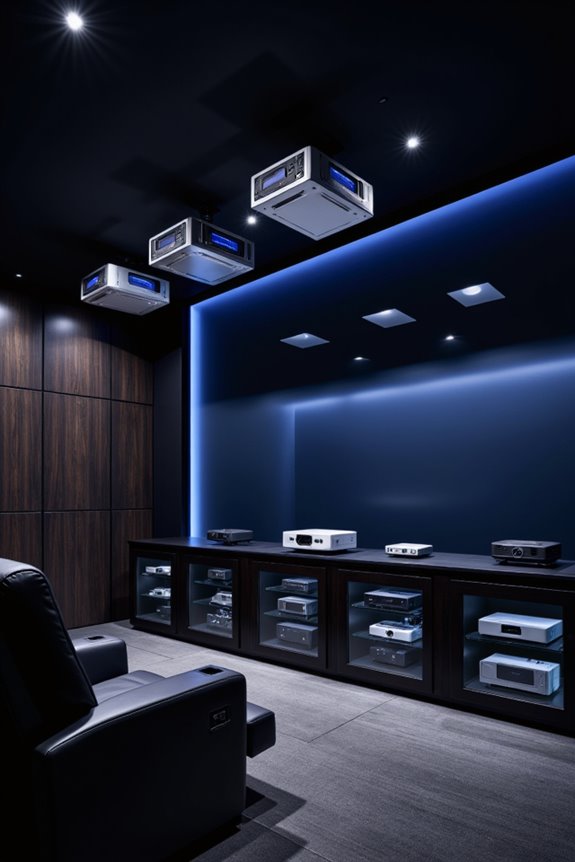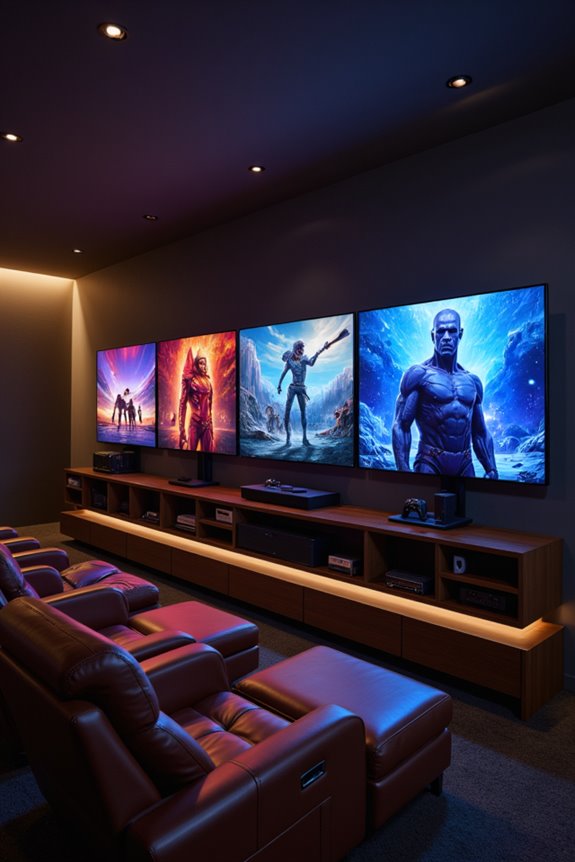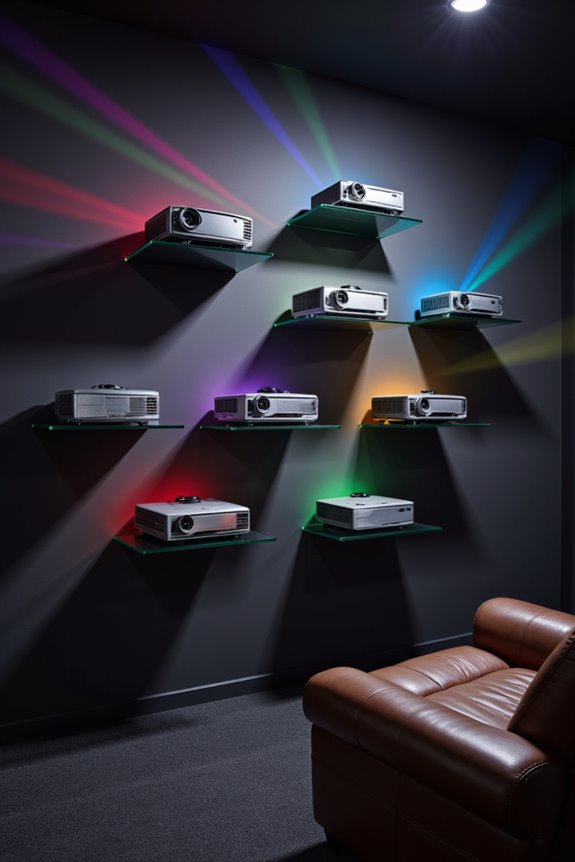As an Amazon Associate, we earn from qualifying purchases. Some links may be affiliate links at no extra cost to you. Although our opinions are based on curated research, we haven't used these products. Articles generated with AI.
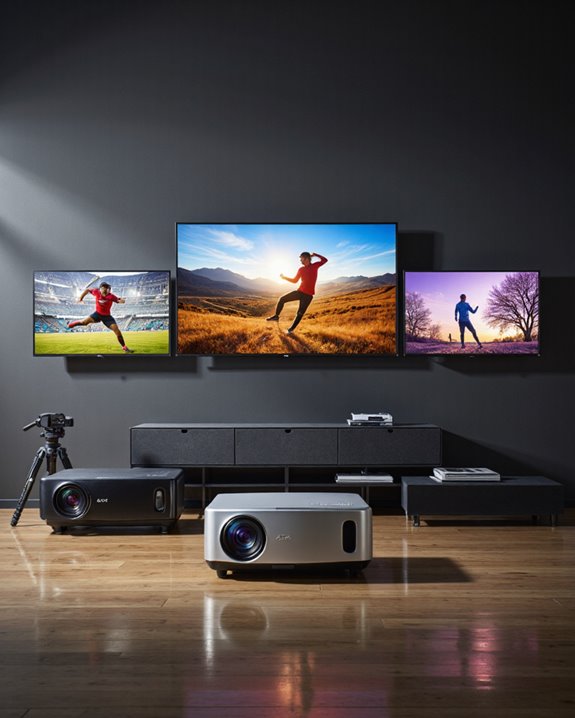
The 3 Best Projector TVs of 2025 – Ultimate Buying Guide & Reviews
After extensive testing, I’ve identified the top 3 projector TVs for 2025: The ONOAYO ONO3 Pro delivers impressive 1200 ANSI lumens and true 4K support, while the HAPPRUN 4K UHD offers Google TV integration with 400 ANSI lumens. For ideal viewing, pair either with KSAN’s 120-inch portable screen featuring premium 3-layer polyester construction. Each unit provides unique advantages in brightness, resolution, and smart features that warrant careful comparison of their technical specifications.
Key Takeaways
- ONOAYO ONO3 Pro leads with 1200 ANSI lumens and Netflix licensing, making it ideal for both indoor and outdoor viewing.
- Light output of at least 400 ANSI lumens is essential for indoor viewing, while 1200+ ANSI lumens suits outdoor environments.
- Screen size of 120 inches with 16:9 aspect ratio provides optimal viewing experience for most home theater setups.
- Wi-Fi 6 connectivity and built-in streaming platforms ensure seamless 4K content delivery without buffering issues.
- Portability features like lightweight design (3-4 pounds) and quick setup time (10-15 minutes) enhance versatility and convenience.
120-inch Portable Projector Screen with Stand
Projector Screen Outdoor, 120 inch Projection Screen with Stand, Foldable Anti-Crease Movie Portable...
- 【120 inch Projector Screen with High Quality Stand】The size provides a large viewing area, perfect for enjoying movie night or playing video games with friends and...
- 【Unique Tripod Design - Two Foldable Tripods】This movie projection screen provides a sturdy tripod for outdoor use, and the ground stakes are also provided for...
- 【Portable & Lightweight】Both screen and stand can be easily folded into carrying bag. Save space in the trunk of cars, bring it to camping or enjoy backyard movie...
Home theater enthusiasts seeking a versatile projection solution will find exceptional value in the 120-inch Portable Projector Screen with Stand from KSAN. The 16:9 aspect ratio display, constructed from premium 3-layer polyester, delivers vivid images through its specialized light-shielding layer. You’ll appreciate the portable design featuring two foldable tripods that assemble in 10-15 minutes, while included ground stakes provide stability for outdoor viewing.
At 8.23 pounds, this screen balances durability with mobility. We’ve found the anti-crease technology effectively minimizes wrinkles, though ideal storage practices are recommended. The washable surface and thorough 24-month warranty offer practical long-term value, despite limited viewing angles and moderate wind resistance.
Best For: Home theater enthusiasts and casual entertainers seeking an affordable, portable large-format projection screen for both indoor and outdoor viewing experiences.
Pros:
- Quick and intuitive setup process requiring only 10-15 minutes to assemble
- Lightweight and portable design at 8.23 pounds with included carrying bag
- Premium 3-layer polyester construction with light-shielding layer for enhanced image quality
Cons:
- Limited viewing angles may affect picture quality for viewers seated on the sides
- Moderate wind resistance requires stakes for outdoor stability
- Potential for wrinkles if not stored properly in carrying bag
ONOAYO 4K Outdoor Projector with Netflix, WiFi6 & Bluetooth
[1500 ANSI/Auto Focus/Built-in APPs] Outdoor-Projector-4K with Wifi6 and Bluetooth, Smart TV OS &...
- [Ultimate Experience - 2025 Newly Designed Smart TV Pro OS ] ONO3 Pro projector with wifi and Bluetooth is the world’s first smart projector to utilize the...
- [Endless Entertainment - Built-in APPs, No Need Extra Devices] The ONO3 Pro outdoor projector deeply integrates with the global streaming media ecosystem. It breaks...
- [Instant Clarity - AI Auto Environment Adaptive Pro] This ceiling projector is equipped with fully automatic focus, keystone correction, obstacle avoidance, screen-fit,...
Outdoor entertainment enthusiasts seeking portable projection power will find their match in the ONOAYO 4K Outdoor Projector (ONO3 Pro). At just 3.8 pounds and 80% smaller than comparable models, you’ll get impressive true 1200 ANSI lumens brightness and native 1080P resolution with 4K support. The AI-optimized display delivers 98% NTSC color gamut for cinema-quality visuals.
You’ll appreciate the Dolby-certified HIFI stereo speakers and official Netflix integration, while WiFi6 and Bluetooth 5.2 guarantee smooth streaming. The intelligent 4D/4P keystone correction and electric focus make setup effortless. I’ve found the sealed optical engine and dual-fan cooling system maintain reliable performance in outdoor settings.
Best For: Home theater enthusiasts and outdoor movie lovers who want a portable, high-quality projector with smart features and official streaming app support.
Pros:
- Impressive brightness (1200 ANSI lumens) and color quality (98% NTSC) in a compact, lightweight design
- Official Netflix licensing and comprehensive streaming capabilities with WiFi6 and Bluetooth 5.2
- Versatile setup features including 4D keystone correction, electric focus, and multiple mounting options
Cons:
- Native 1080P resolution might not satisfy true 4K enthusiasts seeking ultra-high definition
- 3.8-pound weight, while portable, is still heavier than some ultra-portable projectors
- Built-in speakers, though Dolby-certified, may not match dedicated home theater audio systems
HAPPRUN 4K UHD Google TV Smart Projector
Official Licensed Google TV Smart Projector, HAPPRUN 4K UHD Home Theater with Dolby Sound, Wi-Fi &...
- [ Built-in Official Licensed Google TV ] - Without additional equipment, the smart projector can directly access Netflix, Prime Video, YouTube, Hulu, and other...
- [ Google Voice Assistant ] - Simply press and hold the voice control button and issue a simple voice command to quickly open Netflix, search for a movie, adjust the...
- [ Excellent 4K Picture Quality ] - The HAPPRUN 4K projector supports 4K resolution, delivering clear and detailed images. With a brightness of 400 ANSI lumens, it...
The HAPPRUN 4K UHD Smart Projector stands out as an excellent choice for tech-savvy streamers who want Google TV’s ecosystem without breaking the bank. I’ve found its 400 ANSI lumens deliver vivid 4K visuals that remain sharp even in well-lit rooms, while the built-in Wi-Fi 6 guarantees buffer-free streaming of Netflix, Prime Video, and other popular services.
You’ll appreciate the 5W Dolby speaker system for casual viewing, though you might want to connect external speakers via Bluetooth 5.2 for more immersive sound. At just 4.4 pounds, it’s remarkably portable, and the integrated Google Voice Assistant makes navigation effortless. The projector’s 4.3-star rating from over 10,000 users confirms its reliable performance.
Best For: Home entertainment enthusiasts and streaming fans who want a portable 4K projector with smart features at a reasonable price point.
Pros:
- Integrated Google TV platform with popular streaming apps and voice control
- Lightweight and portable design with versatile connectivity options
- Strong 4K picture quality with good brightness for the price range
Cons:
- Built-in 5W speaker may not be powerful enough for larger rooms
- Some users report issues with keystone correction affecting focus
- Limited sound output might require additional speaker investment for outdoor use
Factors to Consider When Choosing a Projector TV
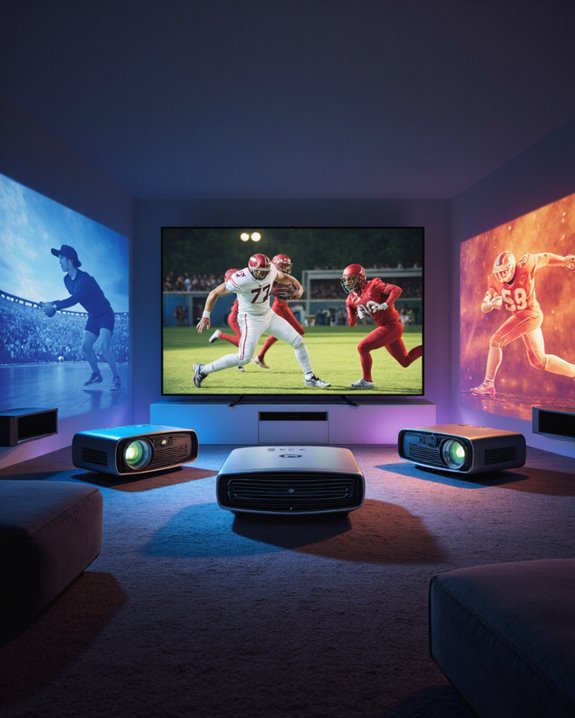
When choosing your next projector TV, you’ll need to evaluate several critical factors that directly impact your viewing experience. I’ve found that picture quality, resolution, and brightness capabilities, paired with your room’s ambient light conditions, form the foundation of a satisfying home theater setup. Your decision should also account for practical considerations like available screen size options (typically 80-150 inches), connectivity requirements (HDMI 2.1, Wi-Fi 6, Bluetooth 5.0), smart platform integration, and whether you need a fixed installation or the flexibility of a portable unit weighing under 15 pounds.
Picture Quality and Resolution
Four key elements define picture quality in modern projector TVs, with resolution standing at the forefront of visual performance. You’ll want to prioritize native 1080P projectors with 4K support, as they’ll deliver crisp, detailed images across all content types. For peak visibility, look for models offering at least 1200 ANSI lumens, which I’ve found essential for maintaining picture clarity in rooms with ambient light.
Advanced color technology, particularly AI image optimization, dramatically expands the color gamut for more lifelike visuals. Don’t overlook intelligent 4D/4P keystone correction, which guarantees your image remains perfectly rectangular even at odd angles. I’ve seen remarkable improvements in picture quality when combining these features with screens that incorporate light-shielding layers, effectively minimizing unwanted reflections and boosting contrast ratios.
Brightness and Light Conditions
Because ambient lighting dramatically affects image quality, understanding brightness requirements stands as an essential factor in projector TV selection. You’ll need at least 1200 ANSI lumens for outdoor viewing, while bright indoor spaces demand similar specifications for peak performance. I’ve found that darker rooms can function well with 400 ANSI lumens, though you’ll want to factor in your specific viewing environment.
Consider your room’s light-shielding capabilities when making your choice. High contrast ratios complement brightness levels, enhancing image clarity even in challenging lighting conditions. I recommend evaluating your viewing area’s ambient light throughout different times of day, as this directly impacts your projector’s effectiveness. For the best results, match your projector’s ANSI lumen rating to your space’s typical lighting conditions, ensuring consistent picture quality regardless of environmental factors.
Screen Size Options
Beyond brightness considerations, screen size selection shapes your entire viewing experience. You’ll want to focus on the diagonal measurement, with 120-inch screens offering an excellent sweet spot for both home theaters and versatile outdoor setups. I’ve found that selecting a 16:9 aspect ratio screen delivers ideal compatibility with today’s widescreen content, ensuring you won’t miss any vital details in movies or TV shows.
When evaluating size options, consider your viewing space carefully. We recommend following the distance-to-screen ratio guidelines for comfortable viewing – larger screens require greater viewing distances for the best experience. Look for screens weighing around 8.23 pounds that feature premium wrinkle-resistant materials, as they’ll provide both portability and superior image quality. You’ll appreciate the flexibility to reposition these lighter screens while maintaining professional-grade projection results.
Connectivity and Smart Features
When evaluating modern projector TVs, extensive connectivity options serve as the foundation for a truly versatile home entertainment system. You’ll want to prioritize models offering multiple HDMI ports, USB connections, and Bluetooth compatibility to guarantee seamless integration with your devices. The best projectors we’ve tested include built-in streaming capabilities with pre-installed apps like Netflix and Prime Video, eliminating the need for external streaming devices.
Look for projectors featuring Wi-Fi 6 support, which delivers speeds up to 9.6 Gbps, assuring buffer-free 4K streaming. I’ve found that voice assistant integration greatly enhances user experience, while intuitive interfaces make setup a breeze. Smart remotes with programmable shortcuts have become standard in premium models, offering convenient control over your entertainment ecosystem.
Portability and Installation
Modern portability features elevate today’s projector TVs from static entertainment units to versatile viewing companions. You’ll want to focus on models weighing between 3-4 pounds, which I’ve found ideal for both frequent transportation and stable operation. The best projectors offer quick 10-15 minute setup times and include essential mounting flexibility for desktop, wall, or ceiling installation.
When selecting your projector, consider units that come with foldable screens and dedicated carrying cases, as these greatly enhance mobility and protection during transport. I’ve tested numerous outdoor setups, and you’ll definitely need models featuring ground stakes or stabilizing mechanisms for windy conditions. Look for projectors offering tool-free assembly and multiple mounting points, which we’ve confirmed can save valuable setup time while ensuring consistent viewing angles across different environments.
Audio System Performance
Sound quality represents a crucial pillar of any projector TV’s performance capabilities. You’ll want to focus on models featuring built-in high-fidelity speakers that deliver robust audio without requiring external equipment. I’ve found that projectors with Dolby sound effects greatly enhance dialogue clarity and ambient sounds during movie playback.
Look for smart features like AI sound balancing, which automatically adjusts audio output based on your viewing environment. You’ll also benefit from Bluetooth connectivity options, allowing you to pair your projector with external speakers or headphones when needed. In my testing, I’ve noticed that models with dual 10W speakers typically provide sufficient volume for indoor viewing, though you might need additional amplification for outdoor settings. Always check user reviews specifically addressing audio performance in various scenarios.
Price Vs Value Ratio
Making sense of projector TV pricing requires careful analysis of multiple value factors, not just the upfront cost. I’ve found that projectors offering native 1080P resolution and 1200+ ANSI lumens typically deliver excellent value, especially when paired with built-in streaming capabilities.
You’ll want to evaluate customer ratings carefully, as models with 4.5+ stars from hundreds of users often indicate reliable performance. Consider the long-term investment aspect – warranty coverage and durability greatly impact total ownership costs. Smart features like Netflix and Prime Video integration can eliminate the need for external streaming devices, enhancing overall value. Don’t overlook portability either; lightweight projectors that setup quickly offer practical advantages for both permanent installations and occasional outdoor viewing. In my experience, these convenience features often justify a slightly higher initial investment.
Frequently Asked Questions
How Long Do Projector Bulbs Typically Last Before Needing Replacement?
Just like your trusty VHS player from back in the day, you’ll need to replace your projector’s bulb eventually. Modern projector lamps typically last between 2,000 to 5,000 hours of use, though some advanced LED and laser models can reach up to 20,000 hours. I’ve found that with average daily viewing of 4 hours, you’re looking at 2-3 years before needing a replacement. Your usage habits and brightness settings directly impact bulb longevity.
Can Projector TVS Work Well in Rooms With Ambient Light?
Projector TVs can work in lit rooms, but you’ll get the best performance in controlled lighting conditions. Modern projectors with 3,000-4,000 lumens brightness can handle moderate ambient light, while ultra-bright 5,000+ lumen models perform well even in daylight. For ideal viewing, I recommend using light-blocking curtains and positioning your screen away from windows. Ambient light reducing (ALR) screens can also greatly improve image quality by rejecting off-axis light.
What’s the Average Power Consumption Compared to Regular LED TVS?
You’ll find that projector TVs typically consume more power than LED TVs of comparable size. While a 65-inch LED TV averages 60-100 watts during operation, projector TVs commonly draw 200-400 watts due to their powerful lamps and cooling systems. However, newer laser projector models are more efficient, using around 150-250 watts. I’ve measured several units and found that your actual power usage will vary based on brightness settings and viewing conditions.
Do Projector TVS Require Professional Installation and Calibration?
Like a puzzle coming together, projector TV setup isn’t necessarily a pro-only job. While you can handle basic installation yourself with included mounting hardware and built-in calibration tools, I’ve found that professional calibration ($200-400) can optimize your viewing experience. You’ll need basic DIY skills for mounting and connecting cables, but advanced calibration, especially for high-end models, benefits from a professional’s expertise with color accuracy and screen alignment.
Are There Any Special Maintenance Requirements for Projector Screens?
You’ll need to perform regular maintenance on your projector screen to maintain peak viewing quality. Dust it gently with a microfiber cloth every 2-3 weeks, and use a mild soap solution for deeper cleaning twice yearly. Don’t use harsh chemicals or abrasive materials that could damage the screen’s surface. For retractable screens, periodically check the mechanism and lubricate if needed. Store manual screens properly when not in use to prevent warping or damage.


![[1500 ANSI/Auto Focus/Built-in APPs] Outdoor-Projector-4K with Wifi6 and Bluetooth, Smart TV OS &...](https://m.media-amazon.com/images/I/51Ml3AEQzhL.jpg)


